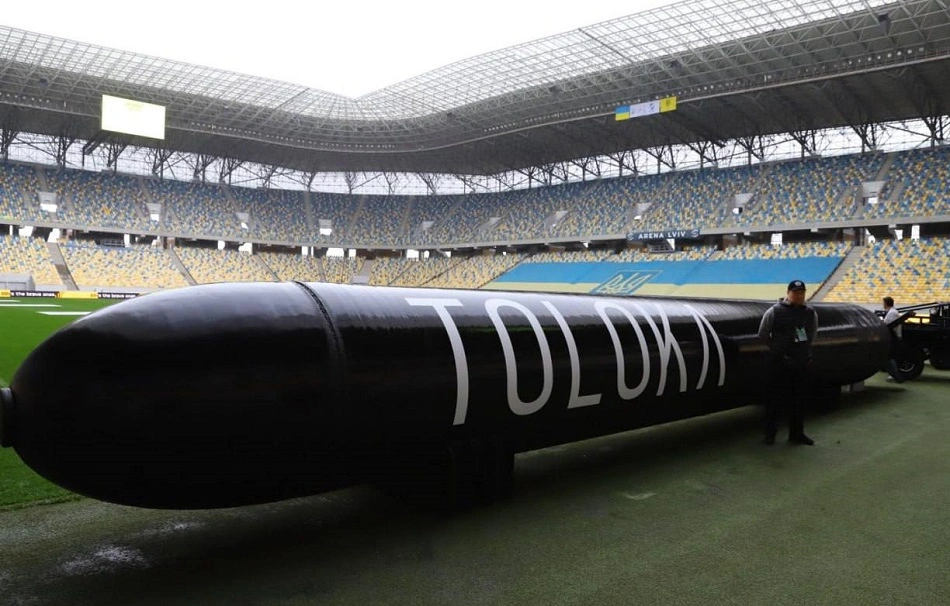In the shadow of invasion, Ukraine’s defense industry unveiled an arsenal of battlefield-tested marvels, from long-range underwater drones to AI-powered interceptors, signaling Kyiv’s emergence as a global hub for military tech.
LVIV, Ukraine — Amid the echoes of air raid sirens that have become all too familiar across this western Ukrainian city, the Arena Lviv stadium transformed into a showcase of defiance and innovation this week, writes DROBRO. At the Defense Tech Valley 2025 summit, Europe’s premier gathering for dual-use defense technologies, Ukrainian engineers and entrepreneurs presented a suite of homegrown weapons and systems that have not just survived the crucible of war against Russia but are poised to redefine global security paradigms.
The two-day event, held on September 16-17 and organized by Ukraine’s Brave1 defense tech cluster in partnership with the Ministry of Digital Transformation, drew over 5,000 participants from more than 50 countries — a testament to Ukraine’s gravitational pull in the world of wartime innovation. Venture capitalists from Silicon Valley rubbed shoulders with military brass from NATO allies, all eyeing prototypes that have already proven their mettle on the front lines. “What survives the battlefield shapes the future of defense tech,” declared Mykhailo Fedorov, Ukraine’s Minister of Digital Transformation, in his opening remarks, underscoring the summit’s theme of turning combat experience into commercial gold.
Переглянути цей допис в Instagram
At the heart of the exhibition stood the TLK 1000, a family of underwater drones that stole the show — or rather, submerged it in awe. Ranging from 4 to 12 meters in length, these uncrewed vessels boast a staggering 2,000-kilometer range and can haul up to five tons of payload, from explosives to surveillance gear. The flagship 12-meter model, dubbed TOLOKA, was demonstrated in a simulated harbor strike scenario, highlighting its stealthy propulsion and modular design for mine-laying or reconnaissance. Developed by a consortium of Lviv-based startups under the Brave1 umbrella, the TLK series represents Ukraine’s pivot toward maritime dominance in the Black Sea, where Russian naval blockades have choked exports and threatened grain corridors. “This isn’t just a drone; it’s a game-changer for asymmetric warfare,” said one engineer from the project, speaking on condition of anonymity due to security concerns.
Beyond the depths, the stadium’s sprawling expo halls buzzed with aerial and ground-based wonders. Over 230 Ukrainian and international firms displayed AI-driven interceptor drones capable of neutralizing kamikaze swarms, laser systems for precision targeting, and ground robotic turrets that navigate urban ruins to down incoming threats. A dedicated “NRC arena” — an obstacle course mimicking war-torn cityscapes, forests, and gravel fronts — allowed attendees to test these bots in live demos, where they autonomously dodged simulated artillery while relaying real-time intel. Electronic warfare jammers and encrypted communication networks rounded out the lineup, innovations born from the urgent needs of Ukraine’s Armed Forces.
The summit’s intellectual core lay in its speaker lineup, featuring over 100 experts. Haluk Bayraktar, CEO of Turkey’s Baykar Defense — makers of the ubiquitous Bayraktar TB2 drones that Ukraine wielded early in the invasion — shared insights on scaling production under fire. Colonel Andrii Lebedenko of the Ukrainian military detailed frontline integrations, while Kimberly Kagan of the Institute for the Study of War analyzed how these tools could export Ukraine’s “lessons learned” to allies facing hybrid threats. Taras Chmut, head of the Come Back Alive Foundation, a key fundraiser for Ukrainian tech, emphasized the human element: “These aren’t gadgets; they’re lifelines forged in the forge of necessity.”
For Ukraine, now in the fourth year of Russia’s full-scale assault, events like Defense Tech Valley are more than trade fairs — they’re lifelines to investment and international legitimacy. The “Battle Proven” competition awarded $60,000 to three startups: Clarity for advanced optics, Dwarf Engineering for compact robotics, and Farsight Vision for AI surveillance, each vetted for real-world deployment. With Western aid flows steady but scrutinized, these gatherings attract funds from the U.S., Europe, the Middle East, and Asia, potentially injecting hundreds of millions into Kyiv’s defense ecosystem. Yet, challenges loom: Intellectual property theft by adversaries and the brain drain of talented engineers remain persistent threats.
As the sun set over Lviv’s cobblestone streets on the summit’s close, the mood was one of guarded optimism. In a nation where innovation is as much about survival as supremacy, these displays at Arena Lviv — from the sleek lines of the TOLOKA to the whir of testing drones — serve as a bold proclamation: Ukraine is not just enduring the war; it’s engineering the peace that follows. For global powers watching closely, the message is clear: Invest now, or risk being outmaneuvered by the underdogs who refuse to yield.
